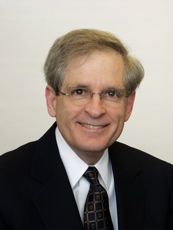BU-incubated company purchased
New glaucoma treatment could help millions save their sight

In the fall of 2001, Doug Adams stepped onto an elevator with Clifford Robinson, Boston University’s director of business incubation, and started talking up his young company, Solx, which had a patent pending for a new glaucoma treatment and a business plan, but not much else. Adams started his pitch on the ninth floor, and by the time he and Robinson reached the building’s lobby, Solx had been added to the roster of fledgling businesses being helped along by BU’s Photonics Center.
Solx reached a milestone on August 31, when it was acquired by Toronto-based OccuLogix, a company specializing in treatments for macular degeneration, another major age-related eye disease.
“We went from a pending patent to building and perfecting prototypes to manufacturing in 20 months,” says Adams, whose company now holds seven patents. He gives BU plenty of credit for his company’s rapid success. As a business incubated at BU, Solx was one of several start-up companies with access to the University’s high-tech labs and machine shops, faculty expertise, student interns, and shared office facilities. In addition, says Adams, “the pedigree of the Photonics Center allowed me to raise money with private investors.”
About 18 companies have been incubated at BU in the past eight years, and they have raised a combined $250 million in investment capital. Because BU has a 16 percent ownership stake in Solx, the University will receive about $1 million initially from the acquisition deal, and a similar amount over the next two years, plus stock in OccuLogix.
Robinson says the real reward, though, is that BU has helped commercialize technologies that could “revolutionize the treatment of glaucoma,” a disease that affects the eyesight of between 2 million and 3 million Americans and about 70 million people around the world, according to the National Eye Institute, part of the National Institutes of Health. Glaucoma occurs when the eye cannot properly drain the aqueous fluid it is constantly producing, leading to increased pressure inside the eye, which can in turn damage the optic nerve and potentially lead to blindness.
The standard of care for most glaucoma patients has been one or more types of prescription eyedrops, taken every day, which either make the eye produce less fluid or make the eye more absorptive. Adams believes Solx offers a better way: a new type of laser treatment, combined with gold “micro shunts,” each about half as thick as a human hair, which help restore the eye’s ability to drain fluid and thus reduce pressure. Both products are currently available in Europe and are in the midst of the final phase of clinical trials here in America.
Along the way, Adams has been an active member of the BU community, serving on the committee that applied for and won a $2.9 million grant from the Wallace H. Coulter Foundation, used to finance annual awards for BU biomedical engineers and clinicians collaborating on new medical technologies. He also is a guest lecturer at the School of Management, where he uses the elevator-pitch story to give students a lesson in entrepreneurship: be clear and succinct about your business vision.
“If you can’t describe your company or business opportunity in 15 seconds, you’ve already lost the audience,” he says.
The story of Solx’s success will help foster more entrepreneurship in BU students and faculty, says Stanford Willie, executive director of BU’s Office of Technology Development and a member of Solx’s board of directors. After all, Willie says, even with help, not every young company makes it. “Some are successful and some are not. Solx has been enormously successful. They’ve been good partners to the University, and their products are going to be of enormous benefit to society.”